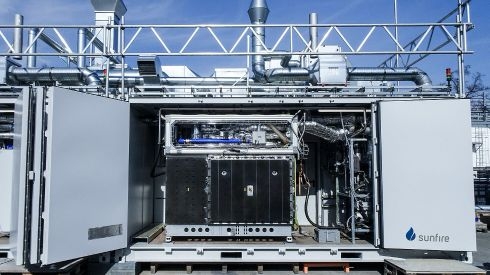Dresden, May 4, 2021
Sunfire reaches next development milestone and doubles capacity of its Solid Oxide Electrolysis (SOEC) module to 225 kW
Sunfire, global leader in solid oxide electrolysis (SOEC) technology, achieves a major milestone in the development of its second generation innovative high-temperature electrolyzers. The company successfully operated and tested a 225 kW (0.225 MW) electrolysis module, which is setting the base for the planned distribution of a multi-megawatt electrolyzer to Neste’s refinery in Rotterdam in the scope of the EU-funded MultiPLHY project.
The SOEC module consists of 60 stacks with 1,800 solid oxide electrolysis cells. It produces 63 Nm²/h of hydrogen from renewable electricity and water steam – this is equivalent to a hydrogen production volume of 5.7 kg per hour. Due to the utilization of steam, high-temperature electrolysis is particularly efficient compared to other electrolysis technologies, reaching a conversion efficiency of 84 %LHV to AC. The power consumption of Sunfire’s SOEC module amounts to less than 40 kWhAC/kgH2. In total, the “Generation 2” high-temperature electrolyzer of Sunfire will consist of twelve SOEC modules, adding up to a 2.7 MW system. Sunfire’s previous “Generation 1″ module consisted of 36 stacks and reached a capacity of 137 kW.
“The cells in Sunfire’s newest SOEC module are connected in series to minimize costs for power electronics. With the successful commissioning of the first module – the heart of every SOEC system – we have achieved a key milestone in the industrialization of SOEC electrolyzers,” says Oliver Posdziech, Head of Large Systems Development at Sunfire.
The optimized SOEC module is designed for industrial manufacturing and will be the core of Sunfire’s multi-megawatt electrolyzer that will be implemented in the pioneering project MultiPLHY. In this project, consortium partners CEA, Neste, Paul Wurth, ENGIE and Sunfire aim at generating green hydrogen for the production of high-quality biofuels at Neste’s refinery in Rotterdam, setting the path for the decarbonization of the oil and gas industry. Launched in spring 2020, the project is part of the EU-funded Horizon 2020 FCH2-JU program and receives 6.9 million EUR funding.
Besides its implementation in the MultiPLHY project, the successful commissioning of the module also paves the way towards the further development of Sunfire’s high-temperature co-electrolysis technology (Co-SOEC) for the highly efficient production of syngas from carbon dioxide and water steam in the BMBF-funded Kopernikus P2X-2 project.

This project has received funding from the Fuel Cells and Hydrogen 2 Joint Undertaking (JU) under grant agreement No 875123. The JU receives support from the European Union’s Horizon 2020 research and innovation programme, Hydrogen Europe and Hydrogen Europe Research.

The BMBF-funded project “Kopernikus P2X-2” (funding code 03SFK2Q0-2) was launched in September 2019 and has a duration of three years. The project focuses on the research, validation and implementation of power-to-X concepts.

Sunfire is a global leader in the production of industrial electrolyzers based on pressurized alkaline and solid oxide (SOEC) technologies. With its electrolysis solutions, Sunfire is addressing a key challenge of today’s energy system: Providing renewable hydrogen and syngas as climate-neutral substitutes for fossil energy. Sunfire’s innovative and proven electrolysis technology enables the transformation of carbon-intensive industries that are currently dependent on fossil-based oil, gas, or coal. The company employs more than 650 people located in Germany.
For more information visit www.sunfire.de